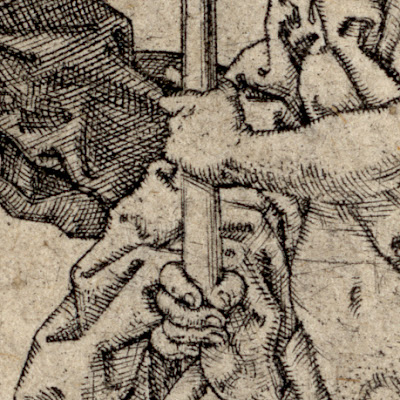Heinrich Aldegrever (c1502–1555/1561)
Left image:
“Diligence”,
1552, from the series, “Virtues and Vices”
Engraving on
very fine laid paper
Size: (sheet)
10.5 x 6.2 cm
Signed with
monogram and dated on a tablet at lower right.
Lettered in
lower margin: “Gaudia tersancti denitat Acedia flatus Ne cum poenie sit
peritura sua.”
TIB
16(8).123(400) (Walter L Strauss & Robert A Koch [Eds.] 1980, “The Illustrated
Bartsch”, vol. 16, p. 195); Bartsch VIII.400.123; New Hollstein (German) 123
(Aldegrever)
The British
Museum offers the following description of “Diligence”:
“With a crane
on the flag at left and a squirrel on the escutcheon; from a series of whole-length
female personifications of the virtues in frontal view with their respective
attributes on banners and shields.” (http://www.britishmuseum.org/research/collection_online/collection_object_details.aspx?objectId=1509052&partId=1&searchText=Aldegrever&page=2)
Right image:
“Envy”, 1552,
from the series, “Virtues and Vices”
Engraving on
very fine laid paper
Size: (sheet)
10.5 x 6.2 cm
Signed with
monogram and dated at upper left.
Lettered in
lower margin: “Sqalida livoris facies pallore voracis Sat genus interi, detegit
omne mali”
TIB 16(8).125(401)
(Walter L Strauss & Robert A Koch [Eds.] 1980, “The Illustrated Bartsch”,
vol. 16, p. 196); Bartsch VIII.401.125; New Hollstein (German) 125 (Aldegrever)
The British
Museum offers the following description of “Envy”:
“Seated on a
porcupine; the escutcheon with a scorpion, the crest a bat, on the flag two
intertwined snakes; from a series of whole-length female personifications of
the vices riding animals and with their respective attributes on banners and
shields.” (http://www.britishmuseum.org/research/collection_online/collection_object_details.aspx?objectId=1509201&partId=1&searchText=Aldegrever&page=3)
Condition: good
impressions from slightly worn plates. Both prints are trimmed close to the
platemark and lined onto support sheets of millennium quality washi paper.
I am selling
this pair of original prints from the Renaissance era for the total cost of AU$660 (currently US$500.05/EUR445.96/GBP391.84 at the time of posting this listing)
including postage and handling to anywhere in the world.
If you are
interested in purchasing these small but visually arresting prints, please
contact me (oz_jim@printsandprinciples.com) and I will send you a PayPal
invoice to make the payment easy.
These prints have been sold
This pair of
prints are almost complementary in their projected moral messages: “Diligence”
(shown on the left) is one of the seven virtues and “Envy” (shown on the
right) is one of the seven vices. Interestingly, the number of virtues and
vices and the assignation of each moral state is underpinned by “biblical
numerical symbolism and Christian moral metaphor” (see https://www.google.com/culturalinstitute/beta/asset/envy/lAETjXrv9vOBXw).
Regarding the
symbolism at the time that the prints were made, the National Museum of
Slovenia (see the above weblink) offers the following marvellous insights about
“Envy”: the pose shown by the female personification of envy riding on the back
of the monster—a porcupine according to the British Museum (!?)—was seen as
indecent. The “entwined snake on the flag and the scorpion on the heraldic
shield … are animals which,
like sin, poison humanity” and the bat was perceived as “a symbol of the
blindness or self-deception caused by envy.” For those (like me) who are unable
to read Latin, the text below the borderline crystallises the meanings of the
portrayed symbolism: “[transl.] A squalid appearance with the pallor of
voracious envy reveals all malice.”











No comments:
Post a Comment
Please let me know your thoughts, advice about inaccuracies (including typos) and additional information that you would like to add to any post.